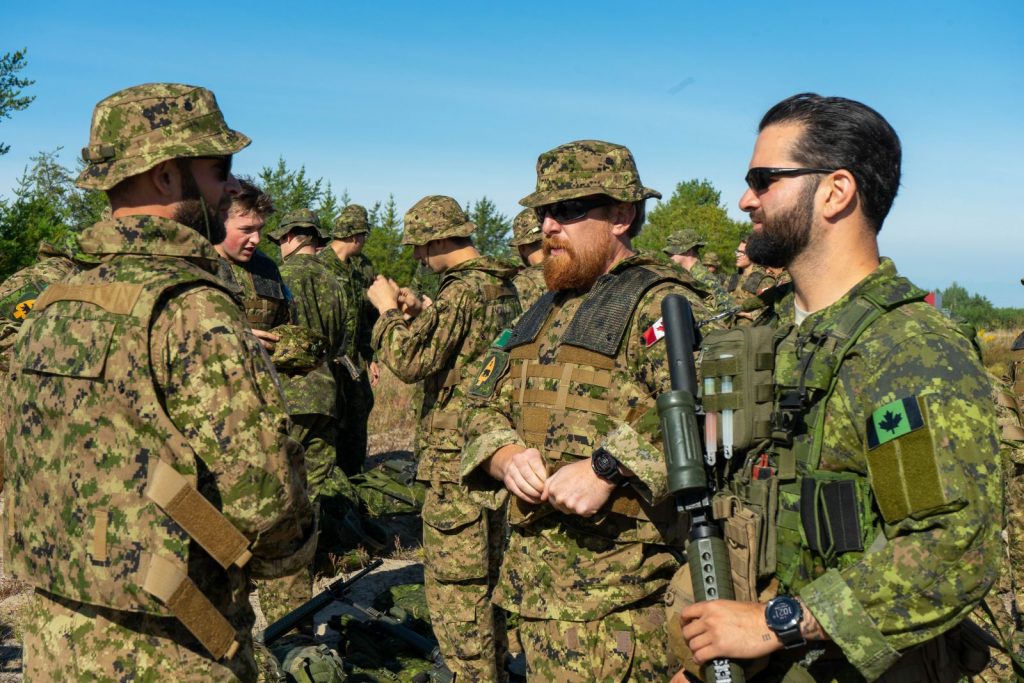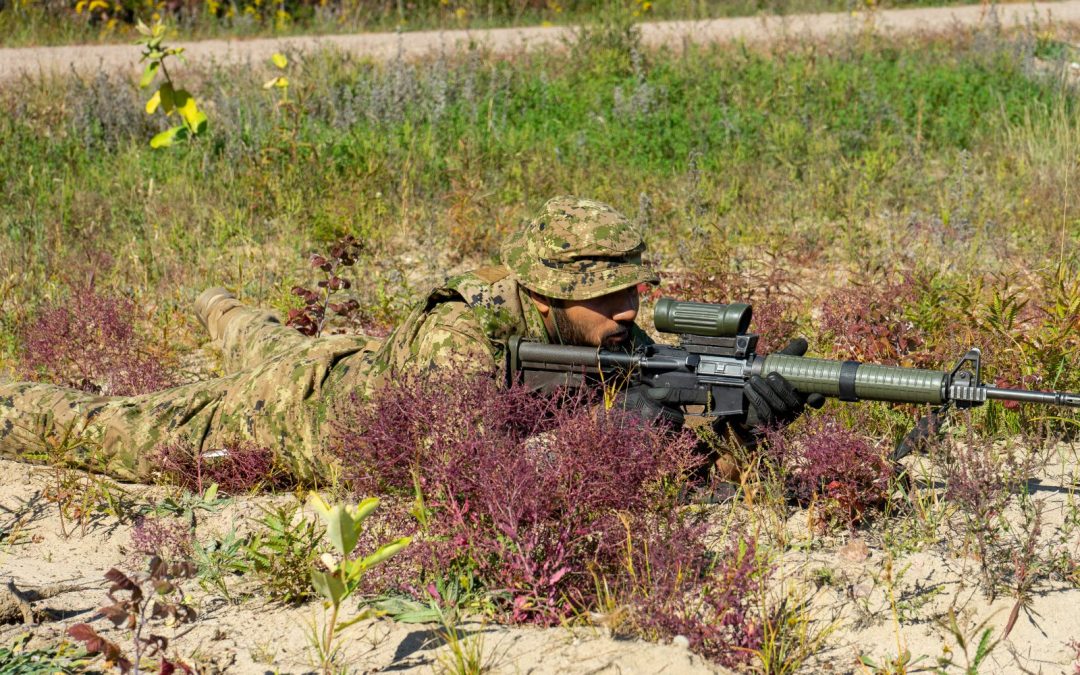When the Soldier Operational Clothing and Equipment Modernization (SOCEM) initiative delivers its first pieces of kit in the coming years, they will come in a new Canadian Disruptive Pattern (CADPAT).
The new camouflage pattern and colour scheme is under review by the Army commander and will likely be a refinement of what was called Prototype J, a predominantly brown scheme with olive and some of the dark green and black of the current temperate woodland CADPAT that was developed by defence scientists and trialed by soldiers over the past 18 months.
The final colour scheme will likely add a fifth colour, a light, sandy shade of brown.
In addition to clothing, the new pattern will be incorporated into the first iteration of operational equipment under SOCEM: Ballistic helmets, ballistic vests and plates, rucksacks and small packs, which will be called patrol packs, and load carriage for equipment such as the current tactical vest. The replacement for the latter could be another tactical vest or a fighting rig, explained Lieutenant-Colonel Ray Corby, program director for the Directorate of Land Requirements.
New operational clothing will be delivered under a separate program known as the Operational Clothing and Footwear Consolidated Contract (OCFC2). A request for proposals (RFP) was issued in August 2019 and amended in February, and would build on the current Consolidated Clothing Contract model whereby soldiers can order and receive clothing from selected vendor’s online catalogues through a points system.
With the question of colour and pattern almost finalized, Corby is focused on the integration of the five initial pieces of operational equipment.
“We need to ensure that it’s an integrated system,” he said. “We want industry to do that work up front and compete an entire system. That causes some challenges for companies that excel in one or a few areas, but not in everything. It’s going to force industry to look at partnerships to have the full range of equipment.”
While the integration of power and communication systems are not central to the gear, vendors will have to ensure “they can accommodate the (Rheinmetall Canada) Integrated Soldier System Suite” currently being fielded across the Army, Corby emphasized.
Future iterations of SOCEM could include cold and wet weather clothing, such as ballistic cold weather goggles and hybrid combat shirts, and new hearing protection.

The SOCEM initiative will also serve as a testbed to help the Directorate for Gender Diversity and Inclusion develop, test and refine human systems integration procedures and a guide. As part of the 2017 defence policy, the Canadian Armed Forces (CAF) was instructed to integrate Gender-Based Analysis Plus (GBA+) to all defence activities, including recruitment, training and equipment acquisition.
“As they try to normalize and integrate GBA+, they have to develop a guide for that process, and they want to use the SOCEM initiative as a test for that,” explained Corby. “That is exciting for us because it gives us more expertise. Some of this equipment is going to have to be really flexible to accommodate the highest number of soldiers as possible. It’s more than gender; it’s body shape and size, fit, occupation and role of the soldier, as well as supply and sustainment issues.”
That will mean greater visibility for SOCEM throughout the CAF, but it will also raise the profile of vendors who can meet the enhanced standards. “We have to make sure we are providing an equipment system that is flexible and modular enough that it can accommodate the needs of soldiers in different roles,” he said. “And for ballistic protection, it is something even industry is struggling with—an acceptable solution for female soldiers. How we move forward on that is going to be very interesting.”
The ballistic kit and packs will be phased in to meet operational requirements as current fleets of equipment are gradually phased out. “We have to look at all the different contracts, the usage rates, and figure out when is the best possible time to introduce a new pattern with new equipment,” said Corby.
The SOCEM team hosted an industry day on Feb. 5 and then met with vendors. He expects at least five or six to propose solutions when a RFP is released later this year.



After the pattern is determined, hopefully the physical design of the cbt shirt, pants and outerwear will be rationalized as well. There are many product improvements that could be made to the existing design that would provide better fit, less weight and bulk and greater usability. A large fitting, generously cut wind proof outer garment could assist in limiting the number of outer layers issued to the CAF.
Large fitting to accommodate the majority of the CF? Make them form fitting to encourage fitness!
I find your articles very informative just curious any information on the future of new pistols for the military
Start here, Mike: https://canadianarmytoday.com/gun-shy-a-protracted-procurement-to-replace-the-general-service-pistol/ More to come on the project in a future issue.
I am curious as to if/when the Canadian armed forces will be receiving new ballistic vests. I am planning to join the infantry and I would like to know what kind of ballistic vest I would be using if I were to be deployed. If anyone has any information please let me know
They use ballistic plates, they are inserted in frag vests on the front and the back.
Our ballistic vest are a lvl 2 soft armor paired with lvl IV hard plates.
It fits poorly, the design being from 20 years ago. It has poor ventilation capability and makes the front plate jam in your throath when you bend over and your back plate site way lower than it should.
God forbid we move to a 21st century solution like a plate carrier with integrated soft armor like the TYR PICO that would cost less than our current setup of frag vest + tax vest…
The new one will just be the same thing with the new color.
If it does come out the timetable won’t be for a bit, and it’s likely to be focused on people going for deployments and the more senior members
Interesting, but a bit more background would have been welcome here. Just why does the Army need to move from the current Woodland pattern to something new? One can understand if new materials make the clothing lighter or more durable or more resistant to thermal detection, but why the change of pattern? Was there a previous article which discussed these matters with the project manager? If yes, a link to it would have been helpful.
Changing the clothing and associated combat gear is not an inconsiderable expense and eats up staff time. What was the operational requirement? Has Canada’s physical geography changed – i.e., has our landscape become ‘browner’ due to climate change? Are some new computer models telling us that the Woodland pattern is a liability? Is the Army adding sandy-brown in order to obviate the need for the arid/desert CADPAT (in which case, this is a money-saving exercise)? Is there some high-level guidance that directs the CAF to devote more thought to operating in the arid regions of the globe? Again, the ‘whys’ and ‘wherefores’ add value to an article such as this.
Dave, you’ll find a bit more here on some of the trials that were conducted by DRDC and the Army to develop the new pattern. Weapon colour was evaluated against the cammo colours and pattern at the time. https://canadianarmytoday.com/the-trials-of-prototype-j/
Thanks, Chris. That article implies that the army is indeed looking for a single pattern, having trialed Prototype J in several different locales. The motivation for one pattern is still unclear, but at this stage it may simply be too early to conclude whether that’s the way to go.
Keep us posted!
That is the idea a universal camouflage pattern. One uniform not 2 or 3 or 4. The problem with the woodland pattern is it looks black at 75m. That is a problem in urban and arid areas. The new uniform will be a great improvement over the dark CADPAT. CAF is not restricted to heavy dark conifer forests. Urban and arid is the expected battleground. The new lighter color will work just fine at home.
Well CadPat works great in the spring and early summer when everything is fresh. But as the season wears on into autumn it loses its effectiveness.
Sorry, last point: the photo showed a soldier in the new pattern, but with a C7A2 sporting the green ‘furniture’. This raises the question of whether other equipment sets (weapons, vehicles) needs to have their colour patterns re-evaluated as the new clothing is introduced, lest they detract from the soldier’s attempts at camouflage. Is this being contemplated?
Camo and concealment is a field force-wide effort, is it not?